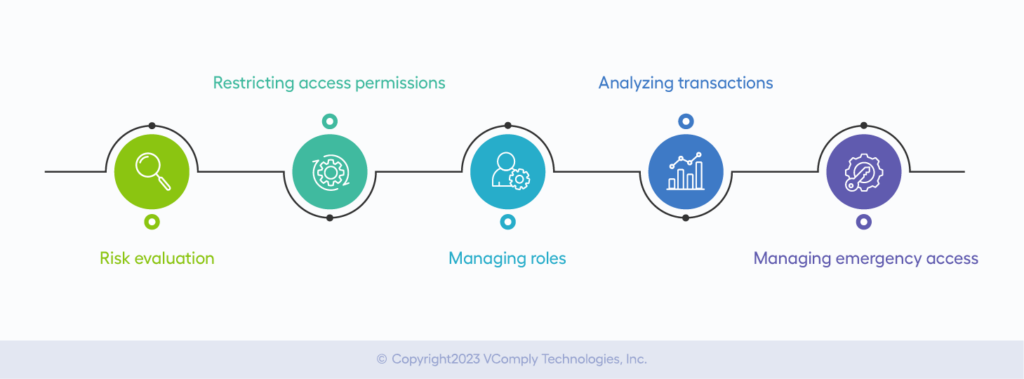Automating Internal Controls: What Does It Entail And What Are The Benefits?
In today’s complex and strictly regulated world, internal controls are a prerequisite as they protect your organization from unethical behavior, violations of regulatory requirements, and monetary losses. However, are just building internal controls enough for your organization to manage and reduce risks?
The answer is no. Internal controls are essential, but they are continually evaluated for the information they produce in terms of quality, speed, and accuracy. Knowing where to begin when creating a system of internal controls can occasionally be challenging. As a result of these challenges, organizations are changing the landscape of their internal control framework through automation.

In this blog, we will uncover the “why” of automating internal controls and discuss the benefits of automation in tackling the risk environment more proactively.
Why should organizations automate internal controls?
Organizations can reduce compliance violations and risks with automation, identify financial risks between systems and applications, enhance data analysis, and improve productivity. According to a Deloitte survey, organizations that automated 50% and 75% of their financial controls did not report any significant flaws or material vulnerabilities over the last two years.
Here are some benefits of carefully integrating automation and cutting-edge technologies into your internal control frameworks.
#1. Comply with legal and regulatory standards
The current situation calls for organizations to optimize their control procedures due to increasing regulatory requirements, pressure from control and compliance authorities, and other factors.
For instance, adhering to regulatory compliance standards like Sarbanes-Oxley Compliance, Information Security, GDPR, CCPA, and so forth requires testing of critical internal controls through sampling approaches. Leveraging automation in your internal control framework can significantly minimize this approach and help companies meet regulatory norms.
#2. Lower operational costs by automating internal controls
Every internal control comes with a price for the organization. The control process needs to be developed, implemented, run, tested, and audited, which entails high expenses.
For example, imagine that a bank with four entries adopted a system to record each time a door sensor alert was triggered to reduce the risk of losses from theft or unlawful access. The financial institution manually logged these details, which took hours of labor and additional operating expenses.
The operational cost of internal control should not be more than the potential rewards of the control or the risk being managed for it to be considered effective. Hence, efficient use of automating internal controls can help organizations:
- Build a cost-effective control environment and
- Reduce redundancy and negligence caused due to manual internal controls
#3. Reduced manual errors
Internal controls work effectively for low-output processes that require human expertise or judgment to determine the process’s outcome. Manual controls have a chance of dysfunction.
Let’s take system access as an example. A manual control compares users to the current employee directory to determine the proper access levels before granting users access. An automated control would use job codes and provisioning profiles and compare the users to the employee directory, and any differences would be automatically resolved.
Automation reduces manual errors by:
- Building robust internal controls in your system in ways that cannot be bypassed
- Improves efficiency and speed
- Streamlines operations by reducing redundancy
- Improves the timeliness and accuracy of data
#4. Create better preventative controls
Preventative controls enable organizations to reduce risks associated with fraud, loss, and obstruction of an organization’s operating goals. This includes supervisory or managerial approvals for both spending and buying transactions, specific control methods for recording cash receipts and disbursements, and password security for all financial data.
For example, employees may not cycle their passwords regularly. Automating this control will automatically require employees to create new passwords regularly. Other benefits of automating preventative controls include:
- Detect unauthorized access to the organization’s data.
- Adds a layer of protection to access third-party data.
- Access to permission controls.
- Shift from a protective, reactive risk-management posture to a proactive one.
#5. Reduce compliance costs
Organizations are seeing a rise in compliance expenditures. Without strong internal controls, they are vulnerable to long compliance processes, a range of risks,
and fines, including theft and embezzlement.
However, simply incorporating internal controls in your compliance process is not enough. When you automate the internal control framework, the long-lasting effects extend to:
- Minimize manpower costs
For example, manpower costs may constitute a sizable portion of Sarbanes-Oxley (SOX) compliance. It is challenging (and expensive) to find and keep qualified compliance specialists who are familiar with generally accepted accounting principles, best practices for financial reporting, and the significance of effective controls.
- Time-consuming processes
Without automation, compliance professionals could be forced to waste time on repetitive, manual procedures such as reconciling data from various sources or ensuring that journal entries are authorized, among others.
#6. Business process improvements
Traditionally, implementing control activities involved adding more people since the separation of duties is the core component of overall risk management.
However, with automation tools to correct internal controls and by automating policies and procedures, employees who had to review the corrective controls manually can now shift their focus to reviewing the accuracy of the output.
At the very core, business processes are improved by adding two layers of review, one within the automated internal controls and the other by human intervention.
Here are some benefits of internal control automation.
- Streamlines operations and increases transparency and efficiency of the process. For instance, automating internal controls makes it simple to spot bottlenecks or ineffective elements of the process and make necessary changes.
- Standardized data collection, such as using predetermined drop-down lists rather than free-text fields.
#7. Separation of duties improves accountability
This internal control activity aims to reduce the risk of errors or inappropriate behavior by dividing responsibilities among several employees. Organizations decrease the possibility of fraud by separating duties so that no one person can carry out, approve, and record financial transactions.
For instance, businesses must separate duties and accountability for those receiving money or checks; making deposits and reconciling deposits; adding new vendors and, processing payments on invoices and, adding and approving expenses.
Separation of duties is prone to various human errors, including insufficient or unqualified staff in accounting departments, which results in rushed work and inadequate documentation of expenses or transactions.
Using intricate role-based authorization models enables you to identify, analyze, and manage associated risks. Other advantages include:

- Risk evaluation
- Restricting access permissions
- Managing roles
- Analyzing transactions
- Managing emergency access
#8. Improves business and controls resilience
Like the disaster recovery process, internal control automation increases control resilience, strengthening the company from the inside out. In a recent Deloitte survey, over 75% of respondents (or 78%) indicated that their organizations intended to improve internal control resilience in the coming years.
Organizations that automate internal controls can:
- Continuously detect risks
- Evaluate the impact and risks
- Monitor risks while putting in place the appropriate number of controls at the appropriate time
#9. Minimize audit expenses
Compliance audits cost businesses millions of dollars. For example, one key requirement of SOX compliance is that organizations have an external audit perform SOX testing over key controls and report on the reliability of their financial statements. This can be an expensive process, particularly for smaller organizations.
According to a survey, organizations with fewer than 25 automated controls in their audit framework spent an average of $1,233,143, whereas those with 25 or more automated controls spent, on average $900,510.
Let’s explore how automating internal controls can lower audit costs.
- Make audits more efficient and cost-effective because all relevant data and supporting documentation are readily available.
- Help lower the compliance costs associated with hiring independent auditors.
- Eliminate regulatory issues that an organization frequently overlooks.
#10. Reduces employee turnover
When employees are used to enforcing internal controls, their exit raises the likelihood of errors and weak internal controls. In the past, the expertise of a valued employee could never be completely replaced.
However, this danger can be mitigated by adopting an automated process with built-in offboarding restrictions. Automating control activities will further help you reduce the risk associated with employee turnover.
How to automate internal controls?
Before developing an internal control plan, organizations must understand the different types of internal controls and how they work. Understanding when and where it makes sense to automate internal controls is the key to success.
Here is a 6-step process for automating internal controls.
#Step 1- Automate what’s necessary – Ensure automation supports your organization’s objectives.
#Step 2- Take small steps – Choose a particular use case related to a high-value activity and is ideally simple to implement.
#Step 3- Observe shortfalls in existing processes – as opportunities for implementing automation.
#Step 4- Determine which controls require automatic testing. For example, customers can be informed about their loan approval and proceedings through an automatic notification instead of sending trails of emails.
#Step 5- Consider the outcomes of automated tests and send reports for audit inspections.
#Step 6- Create a database of tests and findings for future use.
Streamline your internal control management using VComply’s control management software
Automating internal controls is a great place to begin if you want to future-proof your organization’s compliance management system. Doing this can enhance productivity without incurring additional expenses or hiring more employees.
With VComply’s control management software, organizations can:
- Adhere to set norms, evaluate overall performance, and take corrective action
- Develop a compliance and risk management strategy that is laser-focused
- Implement required protocols to address and mitigate risks
- Offers reliable information and easy access to download reports
Automation is one of the most important tools for modern compliance and risk management teams. It plays a critical role in maintaining a lean team environment that is still compliant with all the rules and regulations of your industry.
VComply helps your organization implement automation to strengthen the internal control environment. Equip your employees with the tools they need to become as productive as possible.
Book a VComply free demo and understand how internal control automation works.
